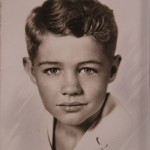Timeline

October 10, 1930
Born in Tulsa, Oklahoma
1942
After several years of financial struggles, Blue family moves to Portland, Oregon
1948-1953
B.A. Degree in Speech and Theater at University of Oregon, Eugene OR
1953-1955
Drafted and served In the army at Fort Bliss in El Paso, Texas
1955-1956
Graduate Work in the Department of Theater, University of Oregon, Eugene, OR
1956-1958
Studied cinematography at L’lnstitut des Hautes Études Cinématographiques (IDHC), Paris, France
1959-1962
Worked for Les Studios Africa (Georges Derocles) in Algiers/Algeria, a private company from which the French government often ordered films. Blue produced seven short films, silent farces mainly intended for the Muslim population, and the documentary Amal (1960), commissioned by the French government.
1961-1962
Co-author and director of Les Oliviers de la Justice, produced by Les Studios Africa (Georges Derocles) and based on a novel by Jean Pélégri. This sole fiction feature film by Blue won the Prix de la Société des écrivains de cinéma et de télévision (séléction: Hommes et Cinéma) at the 1962 Festival de Cannes.
1962-1968
Five documentary films for the film division (director: George Stevens, Jr.) of the United States Information Agency (USIA). Blue directed the “Colombian Trilogy” on the Alliance for Progress – the three short films A Letter from Colombia (1962), The School at Rincon Santo (1962) and Evil Wind Ouf (1962) – and also The March (1963-1964) about the civil rights March on Washington for Freedom and Jobs, August 28,1963. His last documentary, A Few Notes on Our Food Problem (1968), on the improvement of worldwide agricultural production, was Blue’s first color film; it was nominated for an Academy Award (Oscar) for Documentary Feature in 1969, was awarded the CINE (Council on International Non-theatrical Events) “Golden Eagle” and the prize for the Best Documentary, Best Color Cinematography at the 11th International Film Festival Vancouver.
1964
Grant from the Ford Foundation for a research project on film-making consisting of interviews with international directors, starting with Albert and David Maysles. Initially, Blue was interested in the use of non-actors, cinéma verité and Direct Cinema style.
1964-1980
Later, Blue extended this interview project to include historians, critics, new ethnographic documentary filmmakers and actors. Up to his death, Blue conducted more than 75 interviews.
1964
Teaching fellow for film-making at the University of California, Los Angeles (UCLA)
Contributed several essays and interviews to the magazine Film Comment (Blue was one of the cornerstones of its editorial staff)
1964-1969
Contributed several essays and interviews to the magazine Film Comment (Blue was one of the cornerstones of its editorial staff)
1967
Receives Guggenheim Fellowship to develop a script for a feature based on his family’s history. The unproduced scripts that resulted were “King’s Mountain and its Heroes” (with Richard Blue and Gill Dennis) and “Watch for the Razor Act” by Gill Dennis.
1969
Teaching fellow at the Center for Advanced Film Studies, American Film Institute (AFI), Los Angeles. Blue set up its facility and assisted in organizing its curriculum.
1970-late 1970s
Faculty member of the Media Center, first located at St. Thomas College, Houston, and later at Rice University, Houston, TX. The Media Center, where Blue inaugurated the film-making program, was founded by Gerald O’Grady with funding from Jean and Dominique de Ménil. Blue was its Co-Director (together with David MacDougall) from 1970-1975.
1971-1974
Co-Director (together with David MacDougall) of the pioneering five-part ethnographic film project Kenya Boran. It was part of the Faces of Change project, a collaboration between anthropologists and film-makers that included 25 films shot in countries like Afghanistan and Bolivia, produced by the American University Field Staff under director Norman Miller and funded by the National Science Foundation.
1972
Member of the Public Media Advisory Committee of the National Endowments of the Arts (NEA). In following years Blue served on a number of its committees and was recipient of two of its production grants.
1976
Initiator (together with Ed Hugetz) of the weekly television series The Territory, starting with a grant from the NEA as film-maker-in-residence. The program at the public television station KUHT-TV, Channel 8 in Houston, began broadcasting in 1977, featuring independent films, videos and digital arts with an emphasis on Southwestern media artists, and is still operating to this day.
1976-1980
With the documentaries Who Killed Fourth Ward? (1976-1977) and The Invisible City (1979-1980), Blue developed the Complex Urban Documentary, a process-oriented documentary film style for local television employing formal experimentation, interactive elements and audience feedback.
1977
Co-founded the Southwest Alternate Media Project (SWAMP), an independent non-profit media arts center in Houston intended to create audiences and opportunities for regional film and video-making.
1977
Lecture series “The Documentary Impulse” at the Museum of Modern Art, New York
1979
Initiator (together with Producer Lynn Corcoran) and Executive Producer of the television series The Frontier, broadcast on the public television station WNED-TV, Channel 17 in Buffalo. The program showcased the work of independent video and film-makers from Western New York and Southern Ontario.
1977-1980
Professor for Documentary Film at the Department of Media Study, State University of New York (SUNY) at Buffalo, NY
1980

Taught film-making at the National Film School of Great Britain, London, (invited by the director Colin Young)
June 14, 1980
James Blue dies in Buffalo, NY
Timeline adapted from Buffalo Heads, ZKM, 2008, edited by Woody Vasulka and Peter Weibel
